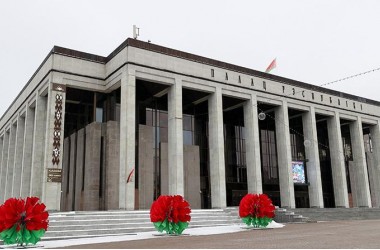According to a recent release of the ratings agency Standard & Poor's, Belarus' country rating remains at the same level. At the same time the agency mentioned increased uncertainty and heightened risks to financial stability. Deputy Chairman of the Board of the National Bank of the Republic of Belarus (NBRB) Dmitry Kalechits analyzed the situation in an interview with BelTA.
The ratings agency Standard & Poor's updated its evaluation of the Belarusian economy the other day. In particular, the agency mentioned challenges to financial stability. What do you think about the current situation?
The situation was evaluated by the National Bank in an annual analytical review “Financial stability in the Republic of Belarus”, which was published last week. The National Bank believes that financial stability remains in place despite all the recent challenges. The financial sector remains resilient towards the most significant risks.
The banking industry operates steadily. The main norms concerning the safe operation of the banks have been ensured. The banks have highly sufficient capital to cover the risks they have undertaken. The solvency and liquidity of the banks remain in place. The level of credit risks is within an acceptable range.
Non-banking financial mediators continue working steady. The payment system operates steadily. Payment risks are limited.
The real sector of the economy receives financial support despite limited resources of the banks.
At the same time the challenges the financial sector has to deal with have increased considerably. The main challenges are related to the credit risk and the liquidity risk. Last year's shocks had a negative effect on the financial state of real sector enterprises, limited their ability to honor their obligations. The high level of foreign currencies in the assets and liabilities of the banking industry also represents a significant risk for the country's financial stability. The foreign debt has increased. Disruptions of the saving process represent a substantial challenge. The disruptions were accompanied by rising demand for foreign currency and determined the pressure on the ruble liquidity of the banks.
Nevertheless, the implementation of a complex of systemic and time-sensitive measures to counteract the shocks has allowed minimizing the risks and preventing disruptions in the operation of the financial sector.
Another shock in the form of Western sanctions has been realized recently. How will it affect the state of the Belarusian financial sector?
Indeed, the sanctions will have a certain effect on the financial sector. One can expect the volume of Belarus' export and respectively the volume of foreign currency proceeds to drop in the future. However, taking into account the high share of import in the Belarusian economy the volume of import will drop as well. All things considered, the influence of Western sanctions on the balance of Belarus' foreign trade will be moderate and extended over a period of time.
Opportunities for attracting foreign funds will be reduced to an extent. It may have the strongest effect on the external state debt where it is necessary to refinance rather large volumes of debt.
One can expect a certain increase in pressure on the foreign currency market. However, taking into account the inertia of any economic processes it will not happen right away. Effects of the external shocks will be manifested gradually. Commercial entities will have to adjust to the new reality.
The floating exchange rate of the Belarusian ruble is an important tool that can be used to absorb external shocks and prevent internal misbalances from accumulating inside the country. The Belarusian ruble is undervalued for now. There are no significant accumulated misbalances in the economy. It will be easier for the economy to adapt to new conditions. The negative effect from the shocks will be softer.
Meanwhile, consequences of the restrictive measures may be worse once internal factors are added to the direct effect on foreign trade and the balance of payments as a whole.
It has to do with expectations of economic agents. The expectations have worsened since last year due to the external and internal shocks. Negative expectations still remain high. As a result, natural persons keep taking money out of the banking system while increasing demand for foreign currency on the home market. In turn, it has a negative effect on resources of financial organizations and their capability to credit the economy. Such expectations may worsen even more as a result of additional shocks.
What measures is the National Bank taking to preserve financial stability amid today's challenges?
The National Bank pursues a balanced policy meant to maintain price stability and financial stability and addition to providing support to the real sector of the economy amid the complicated economic conditions.
For many years the National Bank just like other modern central banks has been working systemically to raise the stability of the banking sector, develop macroprudential regulation, and bolster the institutional foundations that ensure financial stability. The purpose of the work is to build a modern banking system able to counteract new challenges and threats.
Taking into account the world's best practices the National Bank uses up-to-date banking oversight tools. Capital, leverage, and liquidity Basel III standards have been introduced as prudential requirements for banks. These standards are meant to bolster the banking industry, improve its ability to survive shocks resulting from financial and economic stresses regardless of their origin.
Financial stability is one of the main goals the National Bank pursues in addition to price stability. The main macroprudential regulation tools have been introduced to counteract threats to financial stability. A deposit guarantee system has been developed. Persistent steps are taken to develop the credit registry, which contains information about all the credit contracts. The credit registry helps banks better control credit risks. It also gives the central bank additional tools for the early detection of emerging negative trends in the banking sector. The National Bank has enforced a strict mechanism for ensuring the solvency of Belarusian banks.
Within the framework of the monetary policy since mid-2020 the National Bank has been prioritizing the growth of money supply as the most effective way to respond to high negative expectations of economic agents. The banks are granted the necessary support to an extent sufficient for them to satisfy the solvent demand for resources.
The entire system and individual tools for responding to the market situation need to be flexible to work in the new conditions. The flexibility of the exchange rate and the interest rates are the most important mechanisms for absorbing various shocks.
The level of interest rates on the monetary market has increased since the beginning of the year. Banks are gradually adapting to heightened inflation expectations and devaluation ones. At the same time in order to counteract unfair players, who would like to exploit the situation by raising interest rates, we use calculated standard risks, which determine the level of interest rates in systemic banks.
The shrinking resources limit the ability of Belarusian banks to lend more to the economy. Lending is slowing down. Nevertheless, we should note that lending is close to its equilibrium, which is determined by long-term macroeconomic dynamics and current financial conditions.
The National Bank continues pursuing a policy meant to enable financial conditions that favor the steady development of the national economy as much as possible. This is why the rational and effective distribution of financial resources in the economy is an important task. Credit resources should be channeled primarily to competitive commercial entities.
What do you think about the ability of the banking industry to remain stable in the foreseeable future?
By now Belarusian banks have accumulated a certain reserve of resilience. Profitability of the capital and bank assets will preserve the capital of Belarusian banks to an extent sufficient for counteracting possible risks and threats. The banks pursue a cautious policy meant to balance active and passive operations.
The National Bank and commercial banks will continue flexibly and promptly responding to emerging threats. Certainly, it is extremely difficult to predict new shocks, their sequence, and impact. Many factors are outside the National Bank's grasp. However, we closely follow the development of the situation in the economy and on financial markets. Possible risks and the vulnerabilities that threaten the stability of the financial system are being analyzed. Taking into account new threats the early warning system is being improved. Macro scenario stress tests are arranged together with commercial banks.
In conclusion I would like to note that the level of risks has indeed increased. However, the financial sector needs to do its job regardless of shocks. Our work is based on this principle. The entire complex of micro and macroprudential regulations, institutional measures is geared towards reaching this goal and towards enabling favorable conditions for the development of the Belarusian economy.








